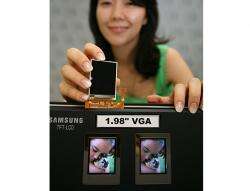Samsung Intros First 1.98'' LCD to Achieve VGA with Amorphous Silicon

Samsung Electronics announced today that it has developed the industry's first 1.98” LCD panel to achieve VGA resolution, using the company's amorphous silicon (a-Si) technology. Mobile phones equipped with this new, display will be able to show Windows screens and documents with the same VGA quality that is provided by most desktop or notebook PCs.
The new mobile LCD panel is being displayed at the SID 2006 Conference in San Francisco June 6 through June 8. The user will be able to enjoy the best quality mobile TV images, with delineation of visual details as small as 63 microns — half the average width of a human hair (120 microns). A typical 40” HD LCD TV has 40 pixels per square inch, while the new 1.98” LCD panel has10 times as many, or 400 ppi.
Samsung has achieved a wide range of technology improvements in the development of its new 1.98” VGA LCD. The company's proprietary, amorphous silicon gates are built into the LCD panel to achieve maximum efficiency in design and module processing. Samsung also has achieved 16 million colors, and the new LCD can accommodate the extremely fast data transmission rates required today.
The new 1.98” VGA LCD is a transmissive LCD with liquid crystals that provide a wide viewing angle. The images are bright (250 nit) and clean (contrast ratio of 300 to 1). It is well suited for mobile products that require high picture quality.
Source: Samsung





















